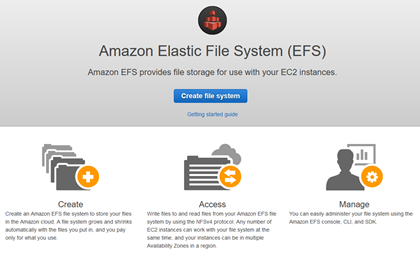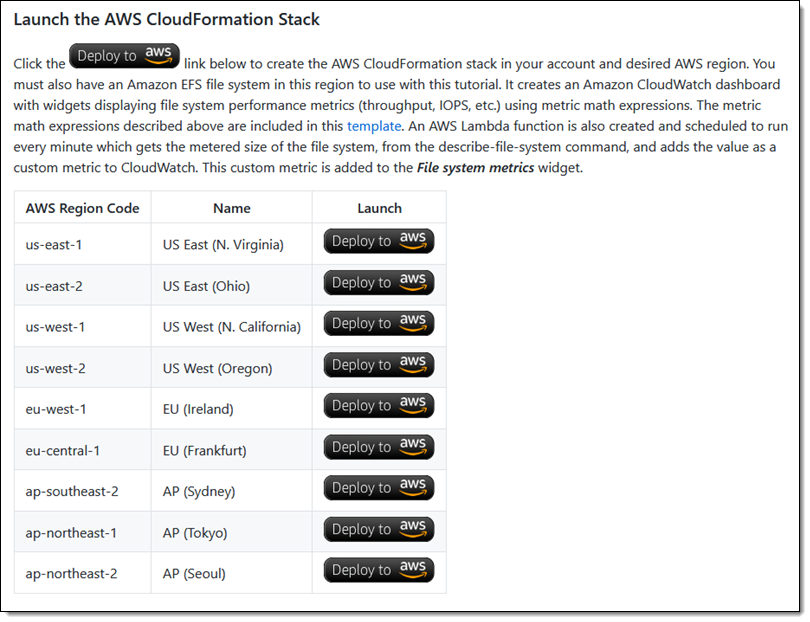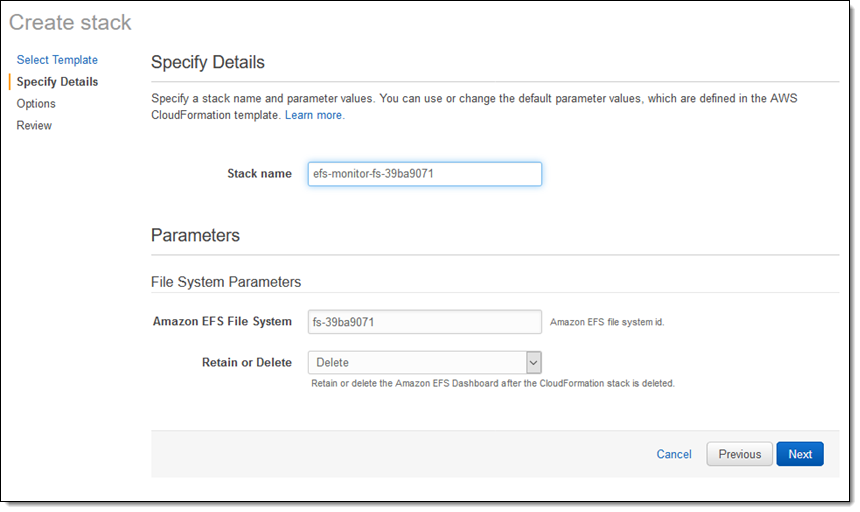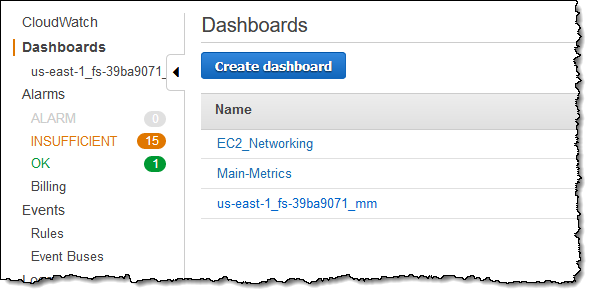New – Provisioned Throughput for Amazon Elastic File System (EFS)

|
Amazon Elastic File System lets you create petabyte-scale file systems that can be accessed in massively parallel fashion from hundreds or thousands of
A Quick Review
 As you may already know, EFS lets you choose one of two performance modes each time you create a file system:
As you may already know, EFS lets you choose one of two performance modes each time you create a file system:
General Purpose – This is the default mode, and the one that you should start with. It is perfect for use cases that are sensitive to latency, and supports up to 7,000 operations per second per file system.
Max I/O – This mode scales to higher levels of aggregate throughput and performance, with slightly higher latency. It does not have an intrinsic limit on operations per second.
With either mode, throughput scales with the size of the file system, and can also burst to higher levels as needed. The size of the file system determines the upper bound on how high and how long you can burst. For example:
1 TiB – A 1 TiB file system can deliver 50 MiB/second continuously, and burst to 100 MiB/second for up to 12 hours each day.
10 TiB – A 10 TiB file system can deliver 500 MiB/second continuously, and burst up to 1 GiB/second for up to 12 hours each day.
EFS uses a credit system that allows you to “save up” throughput during quiet times and then use it during peak times. You can read about Amazon EFS Performance to learn more about the credit system and the two performance modes.
New Provisioned Throughput
Web server content farms, build trees, and EDA simulations (to name a few) can benefit from high throughput to a set of files that do not occupy a whole lot of space. In order to address this usage pattern, you now have the option to provision any desired level of throughput (up to 1 GiB/second) for each of your EFS file systems. You can set an initial value when you create the file system, and then increase it as often as you’d like. You can dial it back down every 24 hours, and you can also switch between provisioned throughput and bursting throughput on the same cycle. You can for example, configure an EFS file system to provide 50 MiB/second of throughput for your web server, even if the volume contains a relatively small amount of content.
If your application has throughput requirements that exceed what is possible using the default (bursting) model, the provisioned model is for you! You can achieve the desired level of throughput as soon as you create the file system, regardless of how much or how little storage you consume.
Here’s how I set this up:

Using provisioned throughput means that I will be billed separately for storage (in GiB/month units) and for provisioned throughput (in MiB/second-month units).
I can monitor average throughput by using a CloudWatch metric math expression. The Amazon EFS Monitoring Tutorial contains all of the formulas, along with CloudFormation templates that I can use to set up a complete CloudWatch Dashboard in a matter of minutes:

I select the desired template, enter the Id of my EFS file system, and click through the remaining screens to create my dashboard:

The template creates an IAM role, a Lambda function, a CloudWatch Events rule, and the dashboard:

The dashboard is available within the CloudWatch Console:

Here’s the dashboard for my test file system:
Available Now
This feature is available now and you can start using in today in all AWS regions where EFS is available.
— Jeff;
相關推薦
New – Encryption of Data at Rest for Amazon Elastic File System (EFS)
We launched Amazon Elastic File System in production form a little over a year ago (see Amazon Elastic File System – Production Ready in Three Reg
Amazon Elastic File System (EFS)
When mounted on Amazon EC2 instances, an Amazon EFS file system provides a standard file system interface and file system access semantics, allow
Amazon Elastic File System(EFS)
Amazon EC2 인스턴스에 탑재되는 경우, Amazon EFS 파일 시스템에서 표준 파일 시스템 인터페이스와 파일 시스템 시맨틱을 제공하므로 Amazon EFS를 기존 애플리케이션 및 도구와 원활하게 통합할 수 있습니다. 여러 Amazon EC2 인스턴스가
Amazon Elastic File System (Amazon EC2のファイルストレージサービス)
Amazon EFS ファイルシステムが Amazon EC2 インスタンスにマウントされると、標準的なファイルシステムインターフェイスと、ファイルシステムアクセスのセマンティクスが提供され、既存のアプリケーションやツールに Amazon EFS をシームレスに統合できます。複數の Ama
New – Custom Metrics for Amazon CloudWatch
You can now store your business and application metrics in Amazon CloudWatch. You can view graphs, set alarms, and initiate automated actions bas
New – VPC Endpoint for Amazon S3
I would like to tell you about a new AWS feature that will allow you to make even better use of Amazon Virtual Private Cloud and Amazon Simple Sto
Ubuntu Error: ENOSPC:System limit for number of file watchers reached
在使用Ubuntu進行開發時,會遇到這個錯誤! 今天使用react-native的時候 這個錯誤的意思時系統對檔案監控的數量已經到達限制數量了!! 造成的結果: 執行的命令失敗!或丟擲警告(比如執行 react-native start 或者開啟 vsocde) 解決方
解決 docker 報錯: Error starting daemon: error initializing graphdriver: backing file system is unsupported for this graph driver
CentOS 7.5 x64下 sudo yum install docker -y systemctl enable docker systemctl start docker 發現啟動失敗 journalctl -xe 查詢獲得報錯 Jan 11 22:4
New – Encryption of Data in Transit for Amazon EFS
Amazon Elastic File System was designed to be the file system of choice for cloud-native applications that require shared access to file-based sto
New P2 Instance Type for Amazon EC2 – Up to 16 GPUs
I like to watch long-term technology and business trends and watch as they shape the products and services that I get to use and to write about. A
New – GPU-Powered Streaming Instances for Amazon AppStream 2.0
We launched Amazon AppStream 2.0 at re:Invent 2016. This application streaming service allows you to deliver Windows applications to a desktop bro
Test the Upload Speed of Amazon S3 Transfer Acceleration for a Specific File Size
Amazon Web Services is Hiring. Amazon Web Services (AWS) is a dynamic, growing business unit within Amazon.com. We are currently hiring So
How to Deploy a Kubernetes Application with Amazon Elastic Container Service for Kubernetes
This tutorial shows you how to deploy a containerized application onto a Kubernetes cluster managed by Amazon Elastic Container Service
New – Server-Side Encryption for Amazon Simple Queue Service (SQS)
As one of the most venerable members of the AWS family of services, Amazon Simple Queue Service (SQS) is an essential part of many applications. P
New: Server-Side Encryption for Amazon Kinesis Streams
In this age of smart homes, big data, IoT devices, mobile phones, social networks, chatbots, and game consoles, streaming data scenarios are every
New – Cross-Region Replication for Amazon S3
We launched Amazon S3 nine years ago as of last week! Since that time we have added dozens of features, expanded across the globe, and red
New – Your User Pools for Amazon Cognito
Amazon Cognito makes it easy for mobile and web apps to easily add authentication, user management, and data synchronization without having to wri
